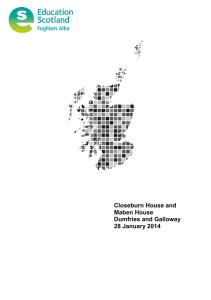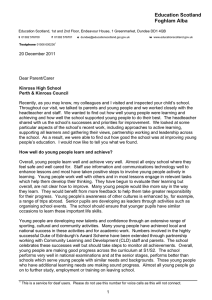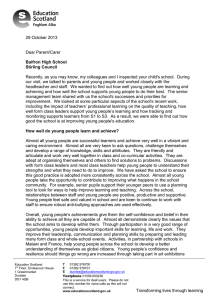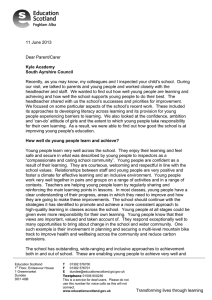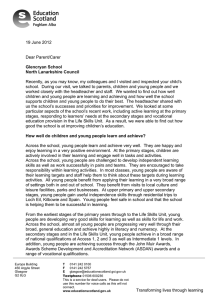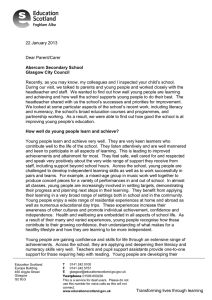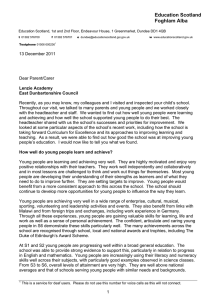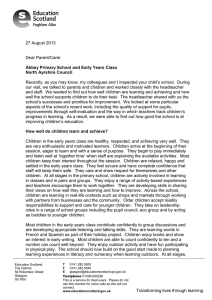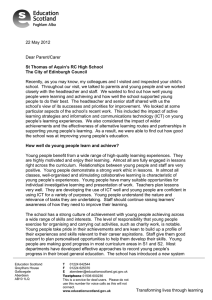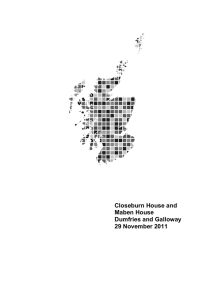Closeburn House and Maben House Dumfries and Galloway
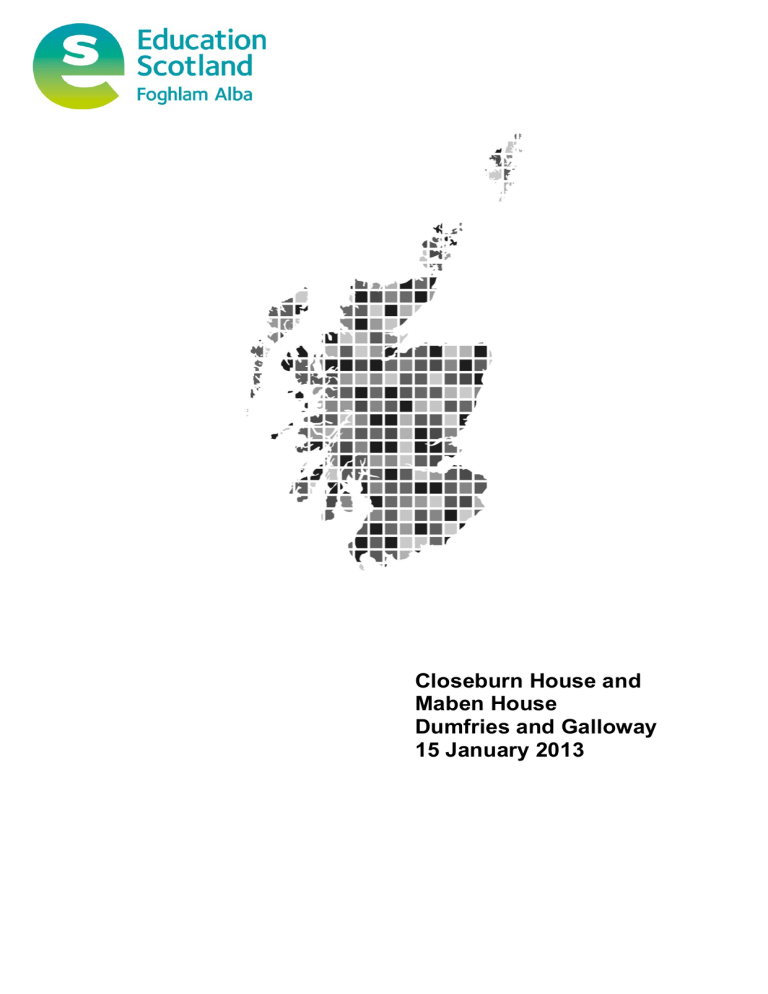
Closeburn House and
Maben House
Dumfries and Galloway
15 January 2013
Education Scotland inspects schools in order to let parents
1 young people know whether their school
2
provides a good
and education. Inspectors also discuss with staff how they can improve the quality of education.
At the beginning of the inspection, we ask the headteacher/senior managers and staff about the strengths of the school, what needs to improve, and how they know. We use the information they give us to help us plan what we are going to look at. During the inspection, we go into classes and join other activities in which young people are involved. We also gather the views of young people, parents, staff and partner agencies who work with the school. We find their views very helpful and use them together with the other information we have collected to arrive at our view of the quality of education.
This report tells you what we found during the inspection and the quality of education in the school. We describe how well young people are doing, how good the service is at helping them to learn and how well it cares for them. We comment on how well staff, parents and young people work together and how they go about improving the school. We also comment on how well the school works with other groups in the community, including services which support young people. Finally, we focus on how well the school is led and how staff help the school achieve its aims.
If you would like to learn more about our inspection of the school, please visit www.educationscotland.gov.uk. Here you can find analyses of questionnaire returns from young people, parents and staff, and where relevant, details about young people’s examination performance. We will not provide questionnaire analyses where the numbers of returns are so small that they could identify individuals.
1
Throughout this report, the term ‘parents’ should be taken to include foster carers,
2 residential care staff and carers who are relatives or friends.
The term ‘school’ includes the nursery class or classes where appropriate.
Contents
1. Background
2. How well do children and young people learn and achieve?
3. How well does the school support children and young people to develop and learn?
4. How well does the school improve the quality of its work?
5. What happens next?
1. Background
In November 2011, HM Inspectors published a report on your child’s school. We returned to the school in December 2012 to look at how it had continued to improve its work. During our visit, we talked to parents, children and young people and worked closely with the headteacher and staff. We heard from the headteacher and other staff how the school has continued to improve.
We looked at particular areas that had been identified in 2011 and at other aspects of the school’s work, as agreed with the headteacher. As a result, we were able to find out how well the school is continuing to improve children’s education. This report sets out what we found.
2.
How well do children and young people learn and achieve?
In most classes children and young people are now more actively involved in their learning. Teachers share regularly the purpose of lessons with children and young people and help them to understand how they can improve. As a result, children and young people are
1
beginning to evaluate their work more accurately. Across the school teachers are now using a wider range of teaching approaches.
Children and young people cooperate well when working in pairs or in groups and would benefit from more of these opportunities. Positive relationships with staff help children and young people feel confident, safe and secure.
3. How well does the school support children and young people to develop and learn?
Staff now plan learning across all areas of the curriculum using
Curriculum for Excellence guidance. Planning to develop health and wellbeing is at an earlier stage. Staff need to give greater emphasis to planning to support children and young people’s health and wellbeing to help them benefit fully from education. Teachers and care staff are planning more effectively together to ensure better integration between school and care settings. Practical activities and learning outside classrooms motivate young people and help them to make links across their learning. There is scope for this good practice to be extended.
The school has recognised the need to further develop approaches to assessing children’s and young people’s attainment, especially in literacy and numeracy. Young people are not involved sufficiently in setting targets which are personal and relevant to them. The school maintains very good relationships with parents who value and support the staff.
4. How well does the school improve the quality of its work?
The recently-appointed head of education has made a good start to providing clear guidance to staff on the curriculum, learning and teaching. He has taken action on important areas that require improvement, including planning of children’s learning. Staff now reflect more on the quality of children’s learning and regularly discuss ways to improve learners’ experiences and meet needs more effectively. Learning should now be improved by systematically
2
gathering the views of young people, care staff and teachers. Staff have not yet had the opportunity to evaluate the work of the service as a whole. Managers should work with staff to ensure that they have a clear view of the strengths and development needs of the school.
5. What happens next?
Since the original inspection, the school has made some important improvements. The head of education is giving a stronger lead and providing staff with a clearer sense of direction. However considerable work remains to be done to improve children and young people’s learning experiences and achievements. Education Scotland will continue to work with the school to provide additional support and we will carry out a further inspection within a year. Following this further inspection, we will write to you to let you know how well the school is continuing to improve.
Olwynne Clark
HM Inspector
3
If you would like to find out more about our inspections or get an electronic copy of this report, please go to www.educationscotland.gov.uk.
Please contact us if you want to know how to get the report in a different format, for example, in a translation, or if you wish to comment about any aspect of our inspections. You can contact us at Enquiries@educationscotland.gsi.gov.uk or write to us at BMCT,
Education Scotland, Denholm House, Almondvale Business Park,
Almondvale Way, Livingston EH54 6GA.
Text phone users can contact us on 01506 600 236. This is a service for deaf users. Please do not use this number for voice calls as the line will not connect you to a member of staff.
You can find our complaints procedure on our website www.educationscotland.gov.uk or alternatively you can contact our
Complaints Manager, at the address above or by telephoning 01506 600259.
Crown Copyright 2013
Education Scotland
